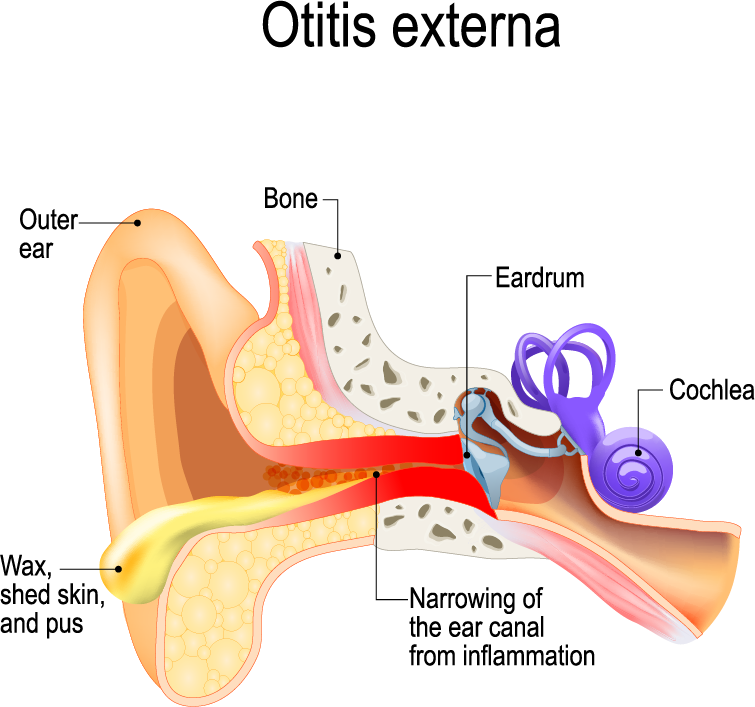Conditions: Otitis Externa (Infection of the Ear Canal)
What is otitis externa?
Otitis externa is an infection of the ear canal that may extend to the outer ear somewhat. This is different from otitis media, which is an infection deep to the eardrum. Otitis externa is not directly related to Eustachian tube dysfunction, unless Eustachian tube dysfunction has caused a perforation in the tympanic membrane.
What are the symptoms of otitis externa?
Ear pain is the primary symptom of otitis externa. This pain may spread and be felt as neck, jaw, and cheek pain. In addition to pain, one can experience decreased (muffled) hearing, and drainage of fluid (pus) from the ear canal.
How is otitis externa diagnosed?
History and physical exam by a physician are the usual steps for making the diagnosis.
what are the types of infection causing otitis externa?
The main two types of otitis externa are bacterial and fungal. Bacterial otitis externa is more common in general, and treatment is therefore typically directed against bacteria. As the Pseudomonas aeroginosa bacterium is a common cause of otitis externa, choice of antibiotic is important. Fungal infection may also occur in the ear canal, particularly when the conditions are favorable for fungus.
How is fungal otitis externa diagnosed?
Fungal otitis externa may be visually diagnosed by a physician if fungal elements are visually present. Seeing these fungal elements (hyphae) is greatly facilitated with use of an ear microscope. Even when fungus is not seen, a suspicion for fungus may be raised by a whitish coloration to the discharge and/or lack of progress when an otitis externa treated with appropriate anti-bacterial antibiotics. The presence of patient factors predisposing to fungal otitis externa also raise suspicion for a fungal infection. Lastly, when diagnosis is uncertain, a swab of the drainage may be sent to the microbiology lab to be tested for the presence of fungus versus bacteria. This sample may be further tested to identify to which medications the involved organism(s) are sensitive.
What factors promote fungal otitis externa?
Fungus is not “caught” or transmitted from an infected source; rather, fungus is everywhere and will thrive when the opportunity presents. Moisture favors both bacterial and fungal otitis externa, but it is especially important in allowing fungus to thrive. Other factors predisposing to a fungal otitis externa include the following:
Recent use of antibacterial eardrops, especially those with a steroid
Weakened immune system, such as with diabetes, especially when poorly controlled, pregnancy, and use of immune-weakening drugs.
Presence of a perforation in the eardrum
History of surgery for cholesteatoma called a canal wall down mastoidectomy.
Use of hearing aids or significant use of earbuds, as they trap moisture in the ear canal
Use of Q-tips or similar
Can the infection spread deeper?
Yes, especially in a situation of poorly controlled diabetes, but also possible in other forms of a weakened immune system, the infection may spread beyond the ear canal skin to the bone or the soft tissues deep to the skin. This is called necrotizing external otitis or malignant otitis externa, and may progress to be fatal.
what are some other problems that may look like otitis externa?
Temporomandibular (jaw) joint dysfunction, which can cause pain in the same area
Otitis media (infection deep to the eardrum, which can cause pain, drainage, and hearing loss
Skin cancer in the ear canal, which often has an infection on the area of skin cancer, making diagnosis of cancer more difficult
Temporo-Mandibular Joint Pain
While not an infection, ear pain caused by the temporo-mandibular joint (TMJ) is commonly assumed to be infection at first. The jaw joint, directly in front of the ear canal, commonly is the source of ear pain in the general population. Additional information may be found in this link from ENTHealth.org. A dentist with a focus on the TMJ is the usual treating provider.
how to get the most from your EAR appointment
Appointment time is valuable. Here are some suggestions to make the most of your appointment. This preparation will help you and your doctor maximize efficiency and accuracy, freeing up time for questions and answers.
This page





